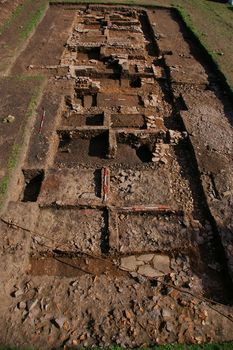Spreadsheet Data from the Caerleon Priory Field Project, 2008-2010
Andrew Gardner, Peter Guest, 2023. https://doi.org/10.5284/1106612. How to cite using this DOI
Data copyright © Vianova Archaeology and Heritage Services, UCL Institute of Archaeology unless otherwise stated
This work is licensed under the ADS Terms of Use and Access.
Primary contact
Prof
Andrew
Gardner
Professor of the Archaeology of the Roman Empire
UCL Institute of Archaeology
UCL Institute of Archaeology
University College London
31-34 Gordon Square
London
WC1H 0PY
UK
Resource identifiers
- ADS Collection: 3170
- DOI:https://doi.org/10.5284/1106612
- How to cite using this DOI
Introduction

This collection comprises spreadsheet data from the Caerleon Priory Field project.
The Priory Field excavation was a research, training and engagement project undertaken by the authors on behalf of Cadw, Cardiff University and UCL. Pioneering geophysical surveys had identified at least 13 previously unknown buildings in Priory Field, including barracks, granaries and one range of a large courtyard building. These belonged to Caerleon’s Roman past when the town was the site of the fortress known as Isca and the base of the Second Augustan Legion. Similarities with the plans of comparable structures led to the suggestion that the courtyard building in Priory Field could have served as the fortress’s main store. The primary purpose of the subsequent Priory Field excavation was to test the hypothesis that the building was indeed a store, and to investigate the history of this part of Caerleon from the Roman period until the present day.
A large trench was positioned over the courtyard building’s southwestern range, which was excavated over 2 seasons in 2008 (4 weeks) and 2010 (6 weeks). The trench exposed the building’s main entranceway and two small adjoining rooms, as well as four small squarer rooms with beaten earth floors, and a length of the colonnaded portico around the courtyard. The building was almost certainly the fortress’s main store where items that were not required by their owners were kept until they might be needed again. This was the first legionary store excavated to modern standards in the Roman Empire. The Priory Field trench generated a very large and diverse finds assemblage that tell us about what was kept there. The coins and pottery also provide an excellent chronological sequence for the building, which was constructed around CE 90-110 and remained in use until the end of the 3rd century, after which it fell into a derelict state before the central part of the excavated range was partially demolished and levelled by around 350. Debris from the derelict building sealed the floors of two store rooms, one of which was littered with military finds, many of which survived in a very fragile condition. These finds included the highly fragmentary remains of at least one set of dismantled lorica segmentata body armour that had been scattered across the room’s floor, as well as another set of unusual scale armour and a rare example of an elaborately decorated horse’s headpiece.
Two new buildings were constructed among the ruins of the old and partially demolished legionary store, including one 3 room cottage-like building. Radiocarbon dates that demonstrate this building was constructed and in use between 430 and 600. This is the first new structure at a Roman site definitively dated to the post-Roman 5th and 6th centuries from Wales and, arguably, from Britain, and it has an important story to tell about life in the old legionary fortress after the ending of Britannia, c. 410.
The excavation report was published in 2023: Guest, P. and Gardner, A. "Excavations in the Roman Legionary Fortress at Caerleon: The Priory Field Store Building." Oxford: Archaeopress.







